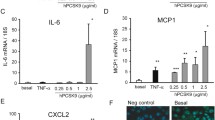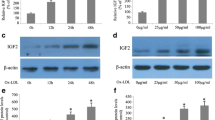Abstract
The role of CRP as a mediator in atherosclerosis and inflammation is being investigated worldwide. In the present study, the effect of CRP on matrix metalloproteinases (MMP)-1, 2, 9, and their tissue inhibitor (TIMP-1) gene expression in THP-1 monocytic cell line was investigated. Specific mitogen activated protein (MAP) kinase (ERK, p38, and JNK) inhibitors were used to elucidate the signaling pathways involved. Effect of atorvastatin was determined in the presence of CRP on the expression of genes. Time and dose-dependent experiments were performed in the presence of CRP. The results showed that the treatment of THP-1 cells with 100 μg of CRP/ml/106 cells for 24 h enhanced the expression of MMPs and TIMP-1 genes significantly. CRP upregulated the expression of these genes via FcγRII and utilized ERK signaling pathway to transduce signals. Atorvastatin was able to significantly attenuate CRP-induced MMPs expression and augmented TIMP-1 gene expression significantly. In conclusion, CRP is not only a risk marker for vascular events, but also directly involved in the mechanisms leading to remodeling and destabilization of atherosclerotic plaque. Also, atorvastatin serves as potential therapeutic modality to curb these harmful events.



Similar content being viewed by others
References
Paffen E, de Maat MPK (2006) C-reactive protein in atherosclerosis: a causal factor? Cardiovasc Res 71:30–39
Packard RS, Libby P (2008) Inflammation in atherosclerosis: from vascular biology to biomarker discovery and risk prediction. Clin Chem 54:24–38
Ridker PM, Rifai N, Rose L, Buring JE, Cook NR (2002) Comparison of C-reactive protein and low-density lipoprotein cholesterol levels in the prediction of first cardiovascular events. N Engl J Med 347:1557–1565
Cermak J, Key NS, Bach RR, Balla J, Jacob HS, Vercellotti GM (1993) C-reactive protein induces human peripheral blood monocytes to synthesize tissue factor. Blood 82:513–520
Williams TN, Zhang CX, Game BA, He L, Huang Y (2004) C-reactive protein stimulates MMP-1 expression in U937 histiocytes through Fc[gamma]RII and extracellular signal-regulated kinase pathway: an implication of CRP involvement in plaque destabilization. Arterioscler Thromb Vasc Biol 24:61–66
Abe N, Osanai T, Fujiwara T, Kameda K, Matsunaga T, Okumura K (2006) C-reactive protein-induced up-regulation of extracellular matrix metalloproteinase inducer in macrophages: Inhibitory effect of fluvastatin. Life Sci 78:1021–1028
Nabata A, Kuroki M, Ueba H, Hashimoto S, Umemoto T, Wada H, Yasu T, Saito M, Momomura S, Kawakami M (2008) C-reactive protein induces endothelial cell apoptosis and matrix metalloproteinase-9 production in human mononuclear cells: implications for the destabilization of atherosclerotic plaque. Atherosclerosis 196:129–135
Mahajan N, Bahl A, Dhawan V (2009) C-reactive protein (CRP) up-regulates the expression of receptor for advanced glycation end products (RAGE) and its inflammatory ligand EN-RAGE in THP-1 cells: inhibitory effects of Atorvastatin. Int J Cardiol. doi:10.1016/j.ijcard.2009.01.008
Pasceri V, Wu HD, Willerson JT (2004) Modulation of vascular inflammation in vitro and in vivo by peroxisome proliferator-activated receptor-gamma activators. Circulation 101:235–238
Venugopal SK, Devaraj S, Yuhanna I, Shaul P, Jialal I (2002) Demonstration that C-reactive protein decreases eNOS expression and bioactivity in human aortic endothelial cells. Circulation 106:1439–1441
Verma S, Li SH, Badiwala MV, Weisel RD, Fedak PWM, Li RK, Dhillon B, Mickle DAG (2002) Endothelin antagonism and interleukin-6 inhibition attenuate the proatherogenic effects of C-reactive protein. Circulation 105:1890–1896
Wang CH, Li SH, Weisel RD, Fedak PWM, Dumont AS, Szmitko P, Ren-Ke Li, Mickle DAG, Verma S (2003) C-reactive protein up-regulates angiotensin type 1 receptors in vascular smooth muscle. Circulation 107:1783–1790
Ross R (1999) Atherosclerosis—an inflammatory disease. NEJM 340:115–126
Libby P, Aikawa M (2002) Stabilization of atherosclerotic plaques: new mechanisms and clinical targets. Nat Med 8:1257–1262
Lee R (1997) The unstable atheroma. Arterioscler Thromb Vasc Biol 17:1859–1867
Davies MJ (1998) Reactive oxygen species, metalloproteinases, and plaque stability. Circulation 97:2382–2383
Galis ZS, Sukhova KG, Lark MAW, Libby P (1994) Increased expression of matrix metalloproteinases and matrix degrading activity in vulnerable regions of human atherosclerotic plaques. J Clin Invest 94:2493–2503
Cleutjiens JPM, Kandala JC, Guarda E, Guntak RV, Weber KT (1995) Regulation of collagen degradation in the rat myocardium after infarction. J Mol Cell Cardiol 27:1281–1292
Newby AC (2006) Do metalloproteinases destabilize vulnerable atherosclerotic plaques? Curr Opin Lipidol 17:556–561
Raffetto JD, Khalil RA (2008) Matrix metalloproteinases and their inhibitors in vascular remodeling and vascular disease. Biochem Pharmacol 75:346–359
Loftus IM (2000) Increased matrix MMP-9 activity in unstable carotid plaques. A potential role in acute plaque disruption. Stroke 31:40–47
Kai H, Ikeda H, Yasukawa H, Kai M, Seki Y, Kuwahara F, Ueno T, Sugi K, Imaizumi T (1998) Peripheral blood of matrix metalloproteinases-2 and -9 are elevated in patients with acute coronary syndromes. J Am Coll Cardiol 32:368–372
Inokubo Y (2001) Plasma levels of matrix MMP-9 and TIMP-1 are increased in the coronary circulation in patients with acute coronary syndromes. Am Heart J 141:217
Force T, Pombo CM, Avruch AJ (1996) Stress activated protein kinases in cardiovascular disease. Circ Res 78:947–953
Kumar S, Boehm J, Lee JC (2003) p38 MAPKs: key signalling molecules as therapeutic targets for inflammatory diseases. Nat Rev Drug Discov 2:717–726
Muslin AJ (2008) MAPK signalling in cardiovascular health and disease: molecular mechanisms and therapeutic targets. Clin Sci 115:203–218
Ballou SP, Lozanski G (1992) Induction of inflammatory cytokine release from cultured human monocytes by C-reactive protein. Cytokine 4:361–368
Blum A, Shamburek R (2008) The pleiotropic effects of statins on endothelial function, vascular inflammation, immunomodulation and thrombogenesis. Atherosclerosis. doi:10.1016/j.atherosclerosis.2008.08.022
Hu WL, Qian SB, Li JJ (2002) Decreased C-reactive protein-induced resistin production in human monocytes by simvastatin. Cytokine 40:201–206
Kibayashi E, Urakaze M, Kobashi C, Kishida M, Takata M, Sato A, Yamazaki K, Kobayashi M (2005) Inhibitory effect of pitavastatin (NK-104) on the C-reactive protein-induced interleukin-8 production in human aortic endothelial cells. Clin Sci 108:515–521
Mahajan N, Dhawan V, Sharma G, Jain S, Kaul D (2008) Induction of inflammatory gene expression by THP-1 macrophages cultured in normocholesterolemic hypertensive sera and modulatory effects of green tea polyphenols. J Hum Hypertens 22:141–143
Han KH, Hong KH, Park JH, Ko J, Kang DH, Choi KJ, Hong MK, Park SW, Park SJ (2004) CRP promotes MCP-1 mediated chemotaxis through upregulating CCR2 expression in human monocytes. Circulation 109:2566–2571
Doronzo G, Russo I, Mattiello L, Trovati M, Anfossi G (2005) C-reactive protein increases matrix metalloproteinase-2 expression and activity in cultured human vascular smooth muscle cells. J Lab Clin Med 146:287–298
Major TC, Liang L, Lu X, Rosebury W, Bocan TMA (2002) Extracellular matrix metalloproteinase inducer (EMMPRIN) is induced upon monocyte differentiation and is expressed in human atheroma. Arterioscler Thromb Vasc Biol 22:1200–1207
Rajagopalan S, Meng XP, Ramasamy S, Harrison DG, Galis ZS (1996) Reactive oxygen species produced by macrophage-derived foam cells regulate the activity of vascular matrix metalloproteinases in vitro. Implications for atherosclerotic plaque stability. J Clin Invest 98:2572–2579
Yasojima K, Schwab C, Mc Geer EG, Mc Geer PL (2001) Generation of C-reactive protein and complement components in atherosclerotic plaques. Am J Pathol 158:1039–1051
Torzewski J, Torzewski M, Bowyer DE, Fröhlich M, Koenig W, Waltenberger J, Fitzsimmons C, Hombach V (1998) C-reactive protein frequently co-localizes with the terminal complement complex in the intima of early atherosclerotic lesions of human coronary arteries. Arterioscler Thromb Vasc Biol 18:1386–1392
Burke AP, Kolodgie FD, Zieske A, Fowler DR, Weber DK, Jacob VP, Andrew F, Virmani R (2004) Morphologic findings of coronary atherosclerotic plaques in diabetics: a postmortem study. Arterioscler Thromb Vasc Biol 24:1266–1271
Ratcliffe NR, Kennedy SM, Morganelli PM (2001) Immunocytochemical detection of FcγR in human atherosclerotic lesions. Immunol Lett 2001(77):169–174
Ryu J, Lee CW, Shin JA, Park CS, Kim JJ, Park SJ, Han KH (2007) FcgammaRIIa mediates C-reactive protein-induced inflammatory responses of human vascular smooth muscle cells by activating NADPH oxidase 4. Cardiovasc Res 75:555–565
Devaraj S, Dasu MR, Singh U, Rao LVM, Jialal I (2008) C-reactive protein stimulates superoxide anion release and tissue factor activity in vivo. Atherosclerosis. doi:10.1016/j.atherosclerosis.2008.05.060
Wu J, Stevenson MJ, Brown JM, Grunz EA, Strawn TL, Fay WP (2008) C-reactive protein enhances tissue factor expression by vascular smooth muscle cells: mechanisms and in vivo significance. Arterioscler Thromb Vasc Biol 28:698–704
Lin R, Liu J, Gan W, Yang G (2004) C-reactive protein-induced expression of CD40–CD40L and the effect of lovastatin and fenofibrate on it in human vascular endothelial cells. Biol Pharm Bull 27:1537–1543
Ichida Y, Hasegawa G, Fukui M, Obayashi H, Ohta M, Fujinami A, Ohta K, Nakano K, Yoshikawa T, Nakamura N (2006) Effect of Atorvastatin on in vitro expression of resistin in adipocytes and monocytes/macrophages and effect of atorvastatin treatment on serum resistin levels in patients with type 2 diabetes. Pharmacol 76:34–39
Qiu G, Hill JS (2007) Atorvastatin decreases lipoprotein lipase and endothelial lipase expression in human THP-1 macrophages. J Lipid Res 48:2112–2122
Takata M, Urakaze M, Temaru R, Yamazaki K, Nakamura N, Nobata Y, Kishida M, Sato A, Kobayashi M (2001) Pravastatin suppresses the interleukin-8 production induced by thrombin in human aortic endothelial cells cultured with high glucose by inhibiting the p44/42 mitogen activated protein kinase. Br J Pharmacol 134:753–762
Negre AP, Van Viiet AK, Van Erck M, Van Thiel GC, Van Leeuwen RE, Cohen LH (1997) Inhibition of proliferation of human smooth muscle cells by various HMG-CoA reductase inhibitors; comparison with other human cell types. Biochim Biophys Acta 1345:259–268
Kashiwagi Y, Haneda T, Osaki J, Miyata S, Kikuchi K (1998) Mechanical stretch activates a pathway linked to mevalonate metabolism in cultured neonatal rat heart cells. Hypertens Res 21:109–119
Acknowledgments
Authors wish to thank Indian Council of Medical Research (ICMR), New Delhi for financial assistance. Nitin Mahajan was awarded Senior Research Fellowship by ICMR, New Delhi.
Author information
Authors and Affiliations
Corresponding author
Rights and permissions
About this article
Cite this article
Mahajan, N., Dhawan, V. Inhibition of C-reactive protein induced expression of matrix metalloproteinases by atorvastatin in THP-1 cells. Mol Cell Biochem 338, 77–86 (2010). https://doi.org/10.1007/s11010-009-0340-x
Received:
Accepted:
Published:
Issue Date:
DOI: https://doi.org/10.1007/s11010-009-0340-x




